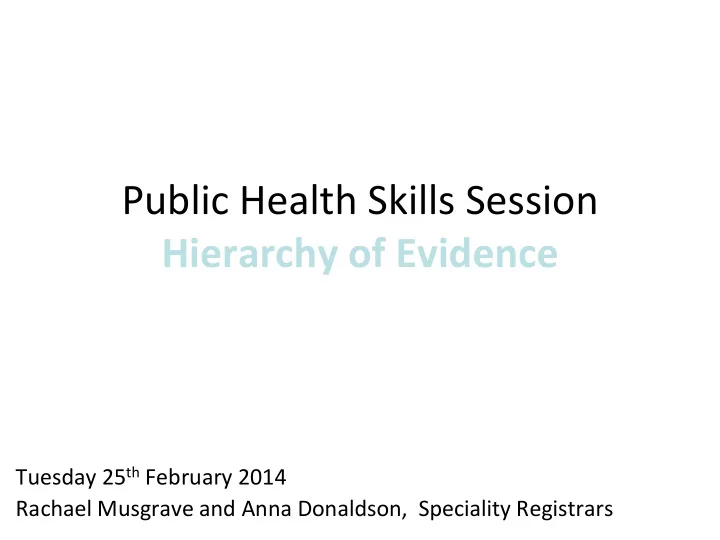

Public Health Skills Session Hierarchy of Evidence Tuesday 25 th February 2014 Rachael Musgrave and Anna Donaldson, Speciality Registrars
By the end of the session… • Understanding of the hierarchy of evidence. • Characteristics of key research methodologies. • Issues and challenges. • Where to go for more information.
What is the Hierarchy of Evidence? • Ranks research methodologies according to their validity. • Evidence based medicine/practice. • A variety of grading systems for evidence and recommendations is currently in use. The system used is usually defined at the beginning of any guidelines publication. • The hierarchy of evidence and the recommendation gradings relate to the strength of the literature.
Systematic Review • Defining an appropriate question. • Searching the literature. • Assessing the studies for eligibility, quality and findings. • Combining the results to provide a ‘bottom line’. Placing the findings in context. •
RCT • Evaluates the effect of a specific treatment or practice. • The intervention being tested is allocated to a group of two or more study subjects (individuals, households, communities). • Subjects are followed prospectively to compare the intervention vs. the control (standard treatment, no treatment or placebo). Randomisation is a key feature. • Looks for incidence or treatment effect in the two groups.
Cohort Study • A group of people are followed over many years to ascertain how variables (such as smoking habits, exercise, occupation and geography) may affect outcome. • They may be prospective or retrospective. Bias is however an issue with retrospective studies but prospective studies are expensive. • The incidence of disease in the exposed group is then compared to the incidence of disease in an unexposed group, and a relative risk (incidence risk or incidence rate) is calculated to assess whether the exposure and disease are causally linked.
Case-Control Study • Starts with the identification of a group of cases: – individuals with a particular health outcome in a given population and; – a group of controls (e.g. individuals without the health outcome) . • Participants are matched. • Good for rare diseases, cost effective but prone to bias. • The odds ratio (OR) is used in case-control studies to estimate the strength of the association between exposure and outcome.
Cross Sectional Study • Data are collected on the whole study population at a single point in time to examine the relationship between disease (or other health related state) and other variables of interest. • This methodology can be used to assess the burden of disease or health needs of a population, for example, and is therefore particularly useful in informing the planning and allocation of health resources. • The main outcome measure obtained from a cross- sectional study is prevalence
Case Reports • The case report is a specific type of research design that reports on an aspect of the management of one or two patients or situations. • Useful in rare cases or for management of cases or situations. • Multiple case reports may be used to generate case series.
Grey Literature • Produced by government, academics, business and industry in print and electronic formats, not controlled by commercial publishers. • Includes: government publications, reports, statistical publications, newsletters, fact sheets, working papers, technical reports, conference proceedings, policy documents and protocols and bibliographies.
Opinions and anecdotal evidence • Expert. • Organisational. • Individual (opinion and personal experience). • Non scientific and non statistical evidence. • Reports, observations, word of mouth.
SR RCT Cohort S Case-control T R E Cross sectional study N G T Case reports H Grey literature £ Opinions and anecdotal evidence
Things to think about….. • Useful when critiquing evidence base for decision making. • Ranking of evidence, versus that which is most relevant to practice. • Bradford Hill criteria: cause and effect. • ‘Publication Bias’ e.g. strength of the research literature and those with favourable results. • Quality of the research. • Cost, time and feasibility. • Practical application e.g. ethics. • The audience and purpose. • Focus on quantitative research methodologies. • Useful when critiquing evidence base for decision making.
More info……… • Health Knowledge • The Cochrane Collaboration • NICE • Centre for Evidence-Based Medicine • Bandolier • Greenhalgh T (1997) How to read a paper; 19, 315.
Thank you Any questions? Next session: Interpreting data Tuesday 25 th March (Beveridge Room)
Recommend
More recommend